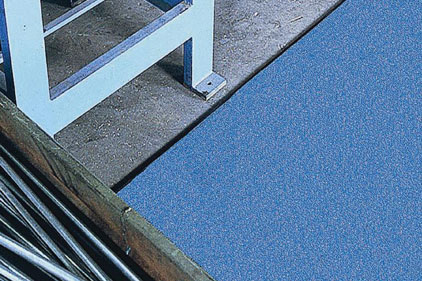This is believed to be a far higher percentage than would have been reported 60 or more years ago because since the early 1950s, most industrial locations have replaced hardwood floors with cement. When walking or standing on a hardwood floor, it “gives a little,” helping to soften each step and minimize discomfort; cement flooring does not “give.”
As workers begin to experience foot and leg pain, they have a tendency to “favor” the other foot or stand or walk in a different manner to help alleviate the pain and discomfort. However, according to APMA, this potentially can cause more problems for the worker, escalate injuries and discomfort, and is more expensive to correct. In many cases, some type of surgical correction is required.
Foot or leg pain can cause a worker’s efficiency to be negatively impacted. It also increases the possibility that an accident or error will happen and can lead to inattention and lower overall worker morale.
Causes of foot and leg pain
A January 2013 study by Penn State Medical Center reports that 75 percent of Americans have foot pain at some time in their lives. According to the APMA, the impact of each step exerts tremendous force on the feet. This force is about 50 percent greater than the person’s body weight. During a typical day, people spend about four hours on their feet and take 8,000 to 10,000 steps. Therefore, the feet support a combined force equivalent to several tons every day. However, workers in many industries are often in a standing position for eight to ten hours each day — potentially severely affecting these workers’ productivity and elevating their health risk level.
In the work environment, most foot pain is caused by simply standing on a hard surface with little relief or movement. Pain may begin with the feet or it may begin in the knees and legs until all lower extremities are experiencing some discomfort.
According to the Canadian Centre for Occupational Health and Safety, standing for long periods of time causes a decrease in blood supply to the lower extremities. This increases fatigue as well as muscle and joint soreness.
Prolonged standing can also result in an accumulation of blood in certain areas of the legs and feet. As a result, localized pressure points in these areas are created, which intensifies pain and discomfort. Often, painful inflammation of the plantar fascia, a thick fibrous band of connective tissue in the foot, occurs.
Some workers may be more susceptible than others to foot and leg pain. For instance, workers over 50 years old tend to be more prone to lower extremity problems because, among other reasons, the fat pads on the bottom of their feet that tend to absorb impacts begin to wear away. Also, some studies indicate women may experience more lower extremity problems than men in a workplace where prolonged standing is required.
Know thy feet
There are many ways workers and employers can help minimize or alleviate lower extremity pain. Workers must first know their feet. A proper shoe insole can be significantly beneficial, but the type needed can vary from person to person. For instance, some people have pronated or flat feet; some have high arches. Wearing insoles with too much arch support for people who already have high arches can increase the likelihood of foot and leg pain.
Employers should advise new hires for jobs that require long periods of standing to meet with a podiatrist before beginning work. The podiatrist can suggest what type of insole and shoes will be most beneficial.
Other than wearing proper shoes, which should always be selected at the end of a typical workday due to swelling of the feet, workers are also advised to take sitting breaks frequently as well as stretch their legs during the course of the day. Even a few minutes off their feet can improve blood flow and help reduce soreness and discomfort.
Still, the most effective way to help prevent foot and leg pain and fatigue involves the floor. Studies were conducted in an aluminum manufacturing plant where workers stand all day to perform their tasks. The company originally used wooden brick flooring in its plants. However, the manufacturer has been replacing the wooden brick flooring with cement. The study found that there was a significant degree of discomfort reported by the workers when the cement floors were installed. In order to compensate for the reported discomfort, the manufacturer began installing anti-fatigue matting in all standing-required workstations. This helped decrease discomfort and fewer problems were reported.
Understanding anti-fatigue mats
Anti-fatigue matting is typically viewed as an inexpensive way to prevent foot and lower extremity aches and pains. These mats essentially provide a cushioned surface to floors and are usually made of vulcanized or nitrile rubber, Zedlan™, a patented foam found in some anti-fatigue mats, vinyl, or other sponge-like materials. According to Richard B. Elsberry, an engineer, “Zedlan foam offers the best balance of softness and resilience for dry environments. [However,] for wet conditions, molded rubber mats…are usually specified.”1
According to Elsberry, anti-fatigue mats help induce natural flexing of muscles as the body makes adjustments to keep its balance. “These adjustments are often imperceptible, but as the muscles tense and relax, blood and oxygen flow through lower extremities, helping to alleviate pain and reduce fatigue,” he says.
Facility managers are advised to purchase quality mats from a well-known manufacturer and a distributor that is well-versed in how these mats work and function. A higher quality mat may cost more, but it will likely last much longer, which makes it more cost-effective in the long run. Some distributors suggest testing mats from two to three different manufacturers and then surveying workers to see which they like the best.
1 “Floor Mats Prevent Fatigue and Reduced Productivity,” by Richard B. Elsberry, published Electrical Apparatus magazine, May 1, 2002.

